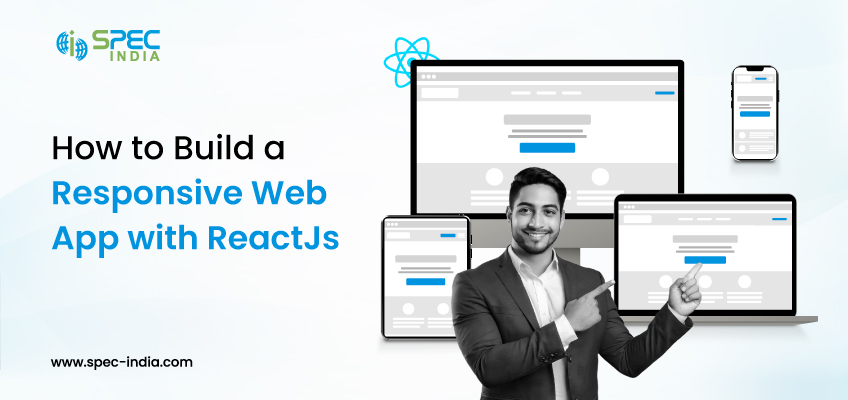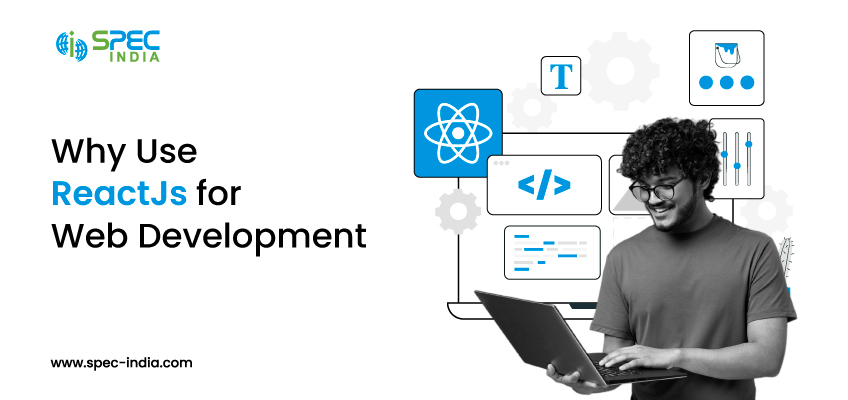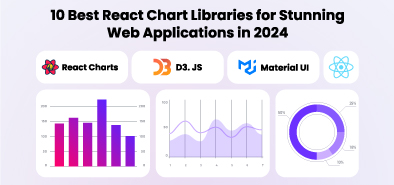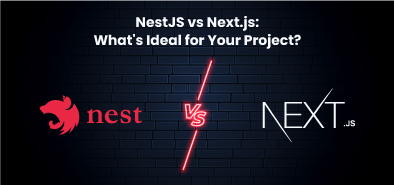Next JS vs Gatsby: Evaluating Two Popular React Frameworks
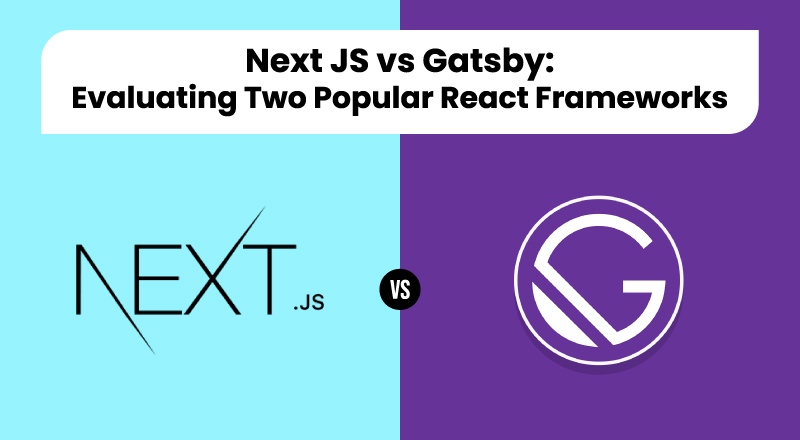
React is a powerful open-source frontend JavaScript library that offers development companies excellent features for developing exclusive interfaces and experiences for high-performance solutions.
Its scalability, adaptability, and flexibility help React developers streamline the frontend development process to offer reliable React development services.
Two popular frameworks have been leveraged for React JS development – Next JS vs Gatsby.
These technologies are apt for creating versatile and robust React websites with salient features like static site generation and server-side rendering.
Both have a lot in common, yet they have differences worth reading.
Before we compare the Gatsby and Nextjs in detail, let’s understand them individually.
What is Next js?
Used by some of the world’s largest companies, Next.js enables you to create full-stack Web applications by extending the latest React features and integrating powerful Rust-based JavaScript tooling for the fastest builds.
Next js is an open-source and free React-based framework apt for creating server-side rendered websites and apps with nearly zero configuration.
The HTML gets directly generated via the server when there is a new request.
It enhances the site’s performance and provides a better user experience when creating landing pages, dynamic websites, and enterprise web apps.
Created by Vercel, Next js collaborates well with other well-known languages, tools, libraries, etc.
There is an augmented user experience with salient features such as routing, data fetching, overall configuration, image optimization, code splitting, etc.
It is like an all-in-one modern application-building solution. It offers a great developer experience for creating frontend applications with ease and efficacy.
Some of its salient features are:
- Hot Reload
- Prefetching
- Automatic routing
- Code splitting
What is Gatsby?
Gatsby is a React-based open-source framework with performance, scalability, and security built-in. Collaborate, build, and deploy 1000x faster with Gatsby Cloud. Gatsby has joined Netlify! Together Gatsby and Netlify are accelerating growth and bringing composable architectures to the modern web.
Gatsby is a free, open-source React framework that can build high-quality and performing apps and websites. It offers a variety of plug-ins, APIs, starters, and themes that can be extendable and generate static HTML pages. Sites in Gatsby can be hosted anywhere, making it one of the most accessible frameworks. It makes use of prerendering pages for better performance and SEO results.
It facilitates the creation of complicated websites and web apps and offers much more than just outputting static HTML files. With its increasing plug-in and starter ecosystem, it develops static and dynamic applications. It provides support for serverless functions and has a server rendering feature. It is the best fit for creating blogs, websites, landing pages, and product pages.
Some of its salient features are:
- Simple learning curve
- Loading data from anywhere
- Optimized for performance.
- Less hosting cost
Next js vs. Gatsby – Pros and Cons
Pros of Next js:
- Inbuilt CSS support
- Easy customization and deployment
- Incremental static generation
- Lightweight and highly scalable
- Automated compilation
- Faster creation of MVP
- High-end data security
- Better user and developer experience
- Faster refresh
- Extensive partner ecosystem
Cons of Next js:
- Poor plug-in library ecosystem
- Opinionated API routing
- Lacks inbuilt state manager
Pros of Gatsby:
- Speedy and exceptional performance
- Modernized standards and workflow
- Multiple data sources
- Extensive community support
- SEO friendly
- Large partner and plug-in ecosystem
- Comprehensive documentation
- Enhanced static website performance
- Low hosting and maintenance cost
- Fast page loading speed
Cons of Gatsby:
- Scaling trouble with larger apps
- It needs to be rebuilt for updates
- Not easily scalable
Next.js vs. Gatsby – Organizations Using Them
Companies Using Next.js:
Docker, Netflix, Uber, Magic Leap, Invision, IGN, TikTok, Hulu, Twitch, Starbucks, Loom, Plex, The Washington Post, Mr Beast, basement, Hashnode, Binance, Ticket Master, Devlieroo, AT&T, etc.
Companies Using Gatsby:
Nike, Figma, Digital Ocean, Hasura, Send Grid, Airbnb Engineering, Braun Canada, Snapchat, Tinder, Revoult, CIA, National Geographic UK, Cloudflare, Riot Games, Calendly, Little Caesars, etc.
Next vs. Gatsby – The Similarities
As you compare the two popular frontend frameworks Next js vs. Gatsby, certain similarities come across; here are they:
- React-based frontend frameworks
- Supports Static Site Generation, Server-Side Rendering, and Client-Side Rendering
- Extensive documentation and tutorials
- Inbuilt performance and caching
- Creation of high-performance websites
- Dynamic web development
- Hot Reloading feature
- Incremental build model
- SEO-friendly with optimization
- Inbuilt routing, code splitting, and optimization
- Faster page loading speed
- Code splitting and bundling
- Page caching, internationalization
- Image optimization
- TypeScript support
- Testing library compatibility
Following JS vs Gatsby: A Vivid Comparison
| Parameters |
Next.js |
Gatsby |
| Overview |
A server-side rendering tool that lets users decide everything. It uses customizing extension plug-ins for an enhanced experience. |
It is an opinionated tool that tells you how to manage data. It uses themes, extensions, and plug-ins to offer an enhanced experience. |
| Application Size |
Medium, large, or enterprise-sized applications wherein data is updated often |
Small or personal-sized applications where data is not updated often |
| Use Cases |
eCommerce/Finance web applications, Web apps/portals with personalization, applications with user authentication and interactions, client-side rendered applications, large multi-user websites, SaaS and B2B websites |
Static content websites, blog websites, marketing websites, company websites, static landing pages, progressive web applications, secure websites, portfolio websites, documentation websites, headless CMS-compatible websites |
| Deferred Rending |
Incremental Static Regeneration (ISR) |
Deferred Static Generation (DSG) |
| Data Handling |
Data may be obtained using any medium, developers can manage data how they want, and a backend is needed to provide data. |
It uses GraphQL to get data, allows developers to fetch the data they need with a rich collection of plug-ins, and depends on APIs and third parties for data. |
| Content Management System |
Fetching data from CMS is a little tricky since it does not have a well-developed plug-in ecosystem. |
Easy connect, update, and edit to CMS through a variety of plug-ins |
| Plug-in Ecosystem |
No |
Yes |
| Support for Rendering |
Supports static and dynamic rendering, renders pages via SSR usage |
Supports static rendering, generates HTML pages during the build time with SSG |
| File Storage |
Requires server deployment |
Makes use of CDN |
| Generates HTML/JS/CSS at runtime |
Generates HTML/JS/CSS at build time |
| Requirement of Server |
It needs a server for its functioning |
It can run even in the absence of a server |
| Extensibility |
Features tools and libraries with various features such as page routing, code splitting, and image optimization. |
It has a comprehensive set of tools and plug-ins that can be used to extend functionalities with pre-configured themes, TypeScript compilers, compressed images, etc. |
| Scalability |
A perfect framework for enterprise use |
Perfect for static web pages and small-sized apps |
| Data Security |
need to set servers up with databases, maintenance, etc., for infrastructure |
Assists developers to create fast web apps by simply prerendering on a build and using a CDN |
| GraphQL Support |
Next doesn’t push GraphQL, so developers have a bit more flexibility |
Since Gatsby is built on GraphQL, data fetching happens through GraphQL queries |
Gatsby vs Next – When to Use What?
Choose Gatsby when –
- There is a need for only static rendering
- You need a quick website with plug-ins
- You are already well-versed in React
- It would be best if you had a broader range of plug-ins and resources
- You plan to create a website with static content
- There is a need to work with different data sources and plug-ins
- You want to work on a smaller project that is stable and easy to setup
- There is a small application to be developed with less development time
Choose Next js when –
- There is a need for both static and dynamic rendering
- It would be best if you chose server-side rendering
- You need a scalable website that can be installed in a serverless environment.
- You need to use more JavaScript and its features
- You plan to create a scalable website with dynamic content
- There is a need for a weight API surface for dynamic and static content
- You want to create a large-scale app for managing lots of content and data
- The project needs to handle lots of content that is growing incrementally
Also Read: Next js vs React: Comparing Two Popular Frontend Frameworks
Choosing Between Gatsby vs. Next js – Summing It Up
Both frameworks, Next JS and Gatsby, are exceptional tools for creating React-based applications. When choosing between the two, other parameters are essential – project requirements, project deadlines and timelines, estimated budget requirements, available skilled resources, and time for a learning curve.
Both offer a great deal of benefits for developers and involved stakeholders.
Whatever you select, it will be a good option because of its salient features and connectivity with your chosen databases and libraries, allowing you to offer a high-performance site/application.
Go on and decide – it will be a lucrative choice!
SPEC INDIA is your trusted partner for AI-driven software solutions, with proven expertise in digital transformation and innovative technology services. We deliver secure, reliable, and high-quality IT solutions to clients worldwide. As an ISO/IEC 27001:2022 certified company, we follow the highest standards for data security and quality. Our team applies proven project management methods, flexible engagement models, and modern infrastructure to deliver outstanding results. With skilled professionals and years of experience, we turn ideas into impactful solutions that drive business growth.



